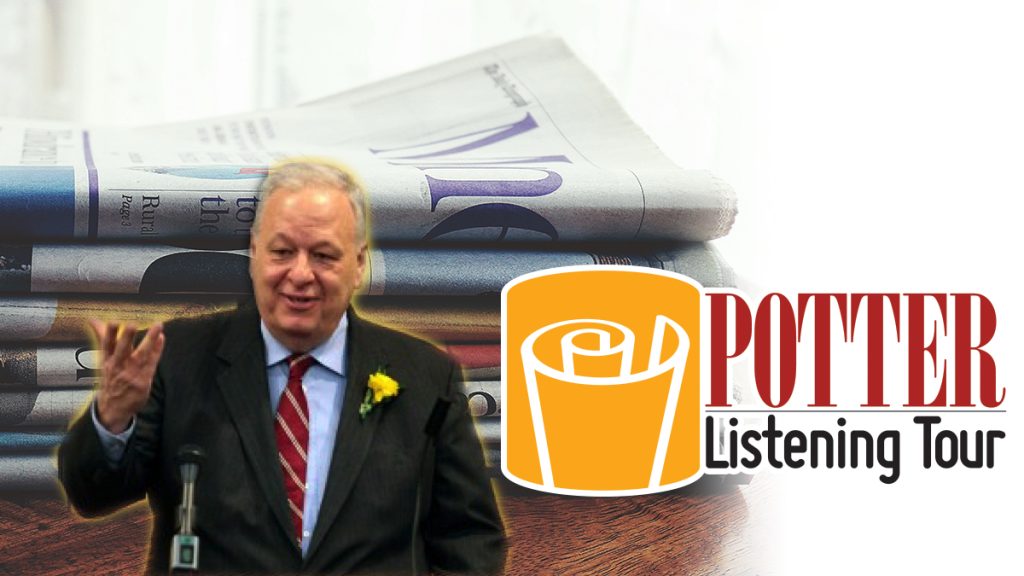
Lessons learned and questions raised during the Potter Listening Tour, Part 2

As an old hand in print newspapers, I was struck by the contrast between the often days-long reporting process I remember and the instantaneous production I strived for during the tour (I posted to Facebook and Twitter). I had to create my words almost at the same time I was recording the words of my subjects.
Ad salespeople for these newspapers have to change, too. Jon K. Rust, publisher of Cape Girardeau’s Southeast Missourian, instituted a program to train all his ad salespeople on computers so they could talk knowledgeably about new digital products to their customers.
Not surprisingly, given this digital culture change, many papers either wanted or had already activated change agents among their employees. Washington Missourian General Manager Bill Miller Jr., for example, hired two digital sales specialists, one each for the Internet and social media. The move was a turning point in boosting digital ad revenue. “Digital is now growing faster than print,” he reported.
Amid all this change, though, I often encountered frustration among my tour hosts with the revenue and profit results of their digital efforts.
Even if digital grows faster, print revenue is still the backbone of the newspaper business model. Even with years of experience with websites, most papers appeared to get only add-on revenue from Internet ad sales. Ads on their websites more often resembled business directories rather advertisers’ sales or other specific promotions.
Social media is even more challenging. Most papers tried to guide the audiences they developed on Facebook and elsewhere back to their websites where those audiences could more easily count with advertisers.
Even with these frustrations, my tour hosts felt they must go digital to maintain and expand their essential relationships with their audience and advertisers. Several papers on the tour promoted their websites as conduits to advertisers’ own sites and even sought to build websites for them. The Southeast Missourian’s parent company, Rust Communications, has gone so far as to create a stand-alone ad agency, Rustmedia, which specializes in helping advertisers use digital tools. “We still have the trust of advertisers,” says Rust, “and we fiercely protect those relationships.”
After nearly two months of listening to these tales of community journalism in 2015, I had notebooks full of problems my hosts wanted solved. Here is their wish list:
- Conduct better research on community newspaper audiences: how are they changing and how fast.
- Recruit advocates for new technology. One suggestion was creating teams of Missouri School of Journalism students who could trade their knowledge of their generation’s Internet use and what they’d learned at the world’s greatest journalism school in exchange for real-world experience.
- Offer multimedia storytelling solutions to newspapers such as those recommended by Missouri School of Journalism professor Judd Slivka.
- Suggest a time-efficient way to track what similar papers are doing in digital, especially what works.
- Create a new business model for community newspapers to help them survive and thrive in the Internet age. Lebanon (Mo.) Daily Record Publisher Dalton Wright suggested the University of Missouri, including its journalism and business schools, launch a formal project to create such a model.
Amid all this talk of whether and how to move their operations to digital, nearly every editor or publisher would voice real concern over the impact such a move would have on their papers’ community mission. They seriously worried whether digital presentations of news would provide the context and accuracy of newspapers’ centuries-old ways of proofing and producing print. “I do believe newspapers are the best model for vetted content where facts are checked, where we get it right,” Lebanon’s Wright said. “I think we’ll have a hard time doing that on radio or in a tweet.”
My conversations with my tour hosts made me think a lot about specific financial and operational challenges these newspapers face, but it also made me ponder broader questions.
It can be argued that the Internet promotes the splintering of communities. It is, after all, the separation of mass audiences into small groups intensely interested in a particular product that is the central appeal of Google advertising, for example.
Perhaps the most important Potter Listening Tour question is: Can newspapers — by aggregating the information flowing within their communities — continue to be a community bulletin board and maintain their vital role as a conversation conduit for their entire community?
Perhaps I’ll find that answer on the next Potter Listening Tour.
